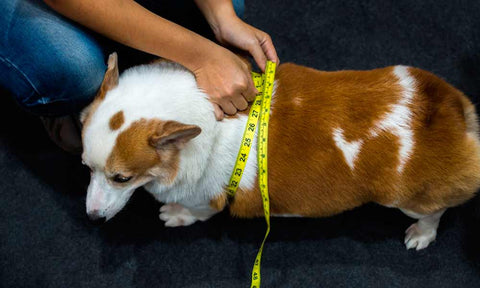Is our number one priority
Tips for Managing Dog Obesity

When a dog consumes more calories than it expends, whether through eating too much or the incorrect foods or exercising insufficiently, it becomes overweight. Every dog, regardless of breed, has the potential to gain weight, but obesity is more common in "big eaters" than in food-loving breeds. Unfortunately, 35–40% of dogs are obese, making it a fairly frequent condition in canines. The issue is most frequently observed in breeds that enjoy food, but it is also frequently observed in neutered male dogs since the lack of testosterone production alters metabolism. Additionally, several medications can aid in boosting appetite.
When is the dog considered overweight?
To begin, a dog is considered overweight if it weighs more than 15% of its normal weight. For example, if you have a dog that normally weighs 20 kg, it is considered overweight if it weighs 23 kg or more. It is therefore critical to understand your dog's normal weight, as a few kilograms may not seem like much in everyday speech, but can make a significant difference in the dog's health and risk causing a variety of other diseases.
Symptoms and consequences
It is simple to tell whether a dog is overweight; some of the most common signs are trouble moving, shortness of breath during exercise, the inability to feel the ribs, and, of course, the appearance of the dog as being overweight.
Obesity puts dogs are at a greater risk for a number of serious consequences like:
- Extra weight puts additional strain on a dog's joints. Arthritis develops as the cartilage in the joint deteriorates.
- Obesity is a well-known risk factor for tearing the ACL (anterior cruciate ligament), a vital ligament in the knee. ACL tears require surgery to repair.
- Obesity can lead to heart disease and high blood pressure. It has also been linked to breathing issues. Overweight dogs are more prone to tracheal collapse and laryngeal paralysis. If left untreated, these airway conditions can lead to a respiratory crisis, which can be fatal.
- During anesthesia, the heart and lungs of overweight and obese dogs have to work harder. Because he has difficulty expanding his chest, the dog has difficulty breathing. Dogs frequently sleep too deeply or too lightly. Furthermore, obese dogs may take a long time to wake up after anesthesia.
- Obesity may increase the risk of certain tumors, including benign fatty tumors (lipomas), breast cancer, and bladder cancer (transitional cell carcinoma).
- Overweight dogs have extra skin folds that can cause irritation and bacterial infection. Scratching, body odor, and skin redness may result. Overweight dogs frequently have an unhealthy-looking coat because grooming them effectively is difficult, if not impossible.
- Obesity can shorten your dog's life by up to two years! The standard of living is also deteriorating. Overweight dogs are slower to get up and down, get winded or tired quickly, and are less likely to play.
The list is very extensive, and obesity is a condition that has to be treated seriously because it not only lowers a dog's quality of life and raises their likelihood of developing all the issues listed above but is also difficult to treat. It takes time and effort to lose extra weight and restore the dog to a healthy weight.
Treatment of obesity
The dog loses weight in the same way that humans do, by lowering calorie intake. The dog must burn more calories than it consumes, and only by doing so will it be able to lose weight. If it consumes exactly what it burns, its weight will not change, but if it consumes more than it burns, it will gain weight. Exercise, in addition to food intake, is important, but it must be appropriate for the dog's ability. Because of their poor health, not all obese dogs tolerate long walks. As a result, the exercise must be tailored to the dog's needs and can be increased as it loses weight.
To assist the dog in reducing calorie intake, a special slimming food must be provided. A diet high in fiber and low in calories ensures that the dog consumes fewer calories while still feeling full. This low-calorie diet must contain all of the necessary vitamins, minerals, and proteins. As a dog owner, it is critical that you do not keep the dog on its old food and only reduce portions. If this occurs, the dog will not receive the necessary vitamins, minerals, and proteins to function optimally, and it will continue to be hungry, which can be extremely frustrating for the dog.
If the dog receives treats during training or walking, the treats must be formulated for overweight dogs, and the calorie intake must be deducted from the dog's total calorie intake for the day.
Weighing the dog at regular intervals is a good idea. If you have a large dog, you can borrow the vet's large scale to keep track of the dog's weight and leave nothing to chance.
Weight loss does not happen overnight; it takes effort and discipline. As a result, it is critical that you, as a dog owner, consult with your veterinarian and develop a realistic program in which the appropriate amount of feed and exercise is carefully planned in relation to the dog's condition and age.